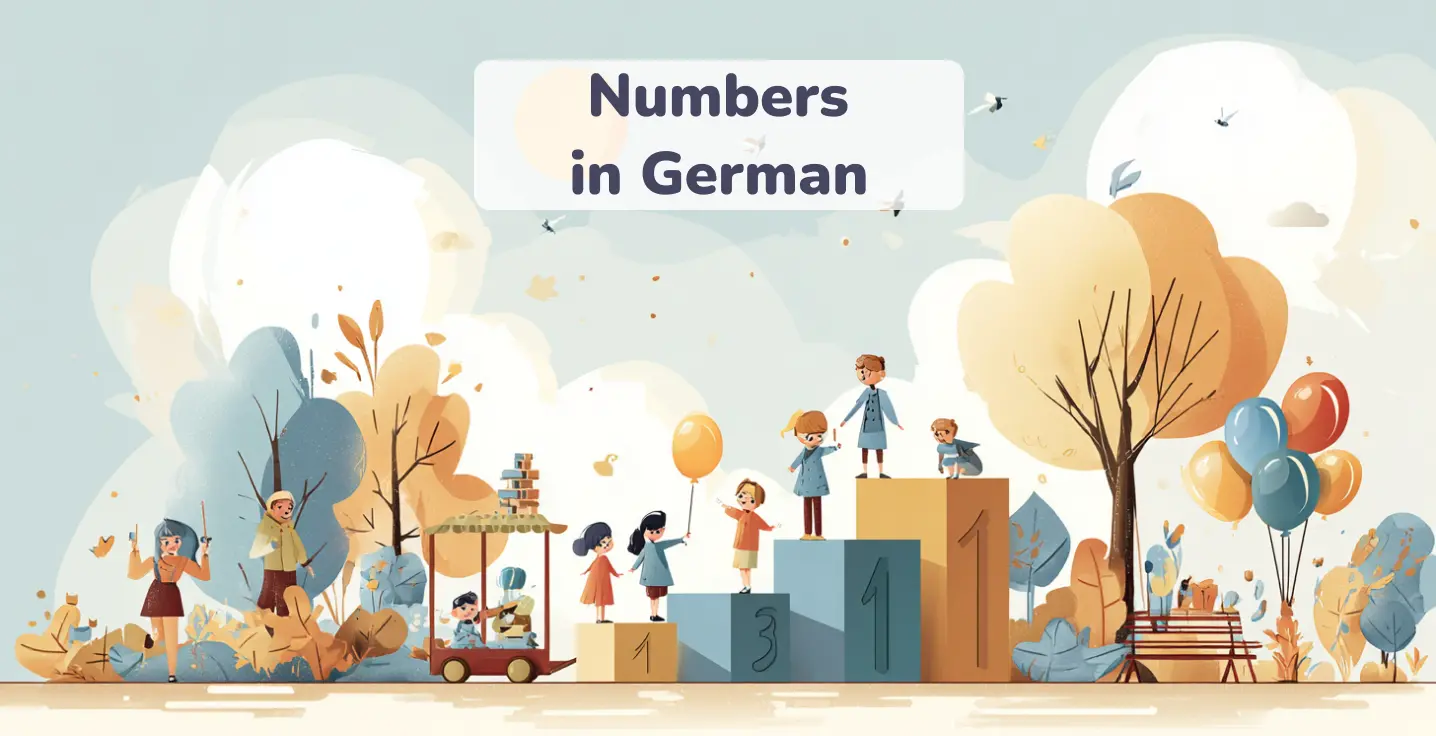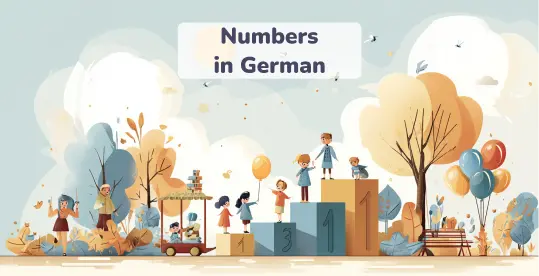How to Count in German: Full Number List
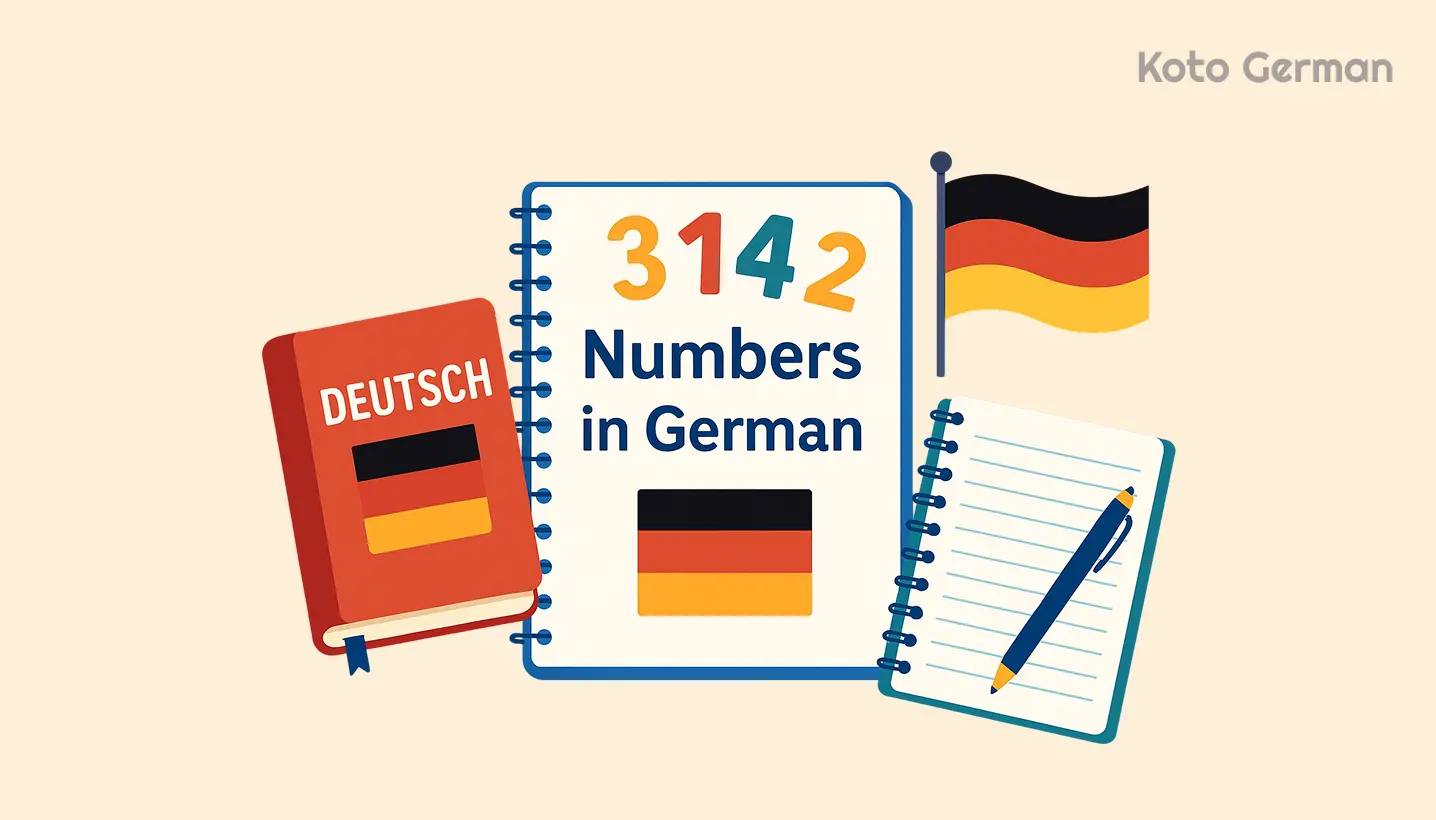

The road to fluent German numbers begins with the simple digits zero through twenty — the foundation for all that comes next. From there, the language flips the usual order when combining tens and ones, which might catch you off guard. Finally, we’ll explore how to say hundreds, thousands, and millions, making sure you know the pronunciation and rules behind them.
Basic Numbers (0–20)
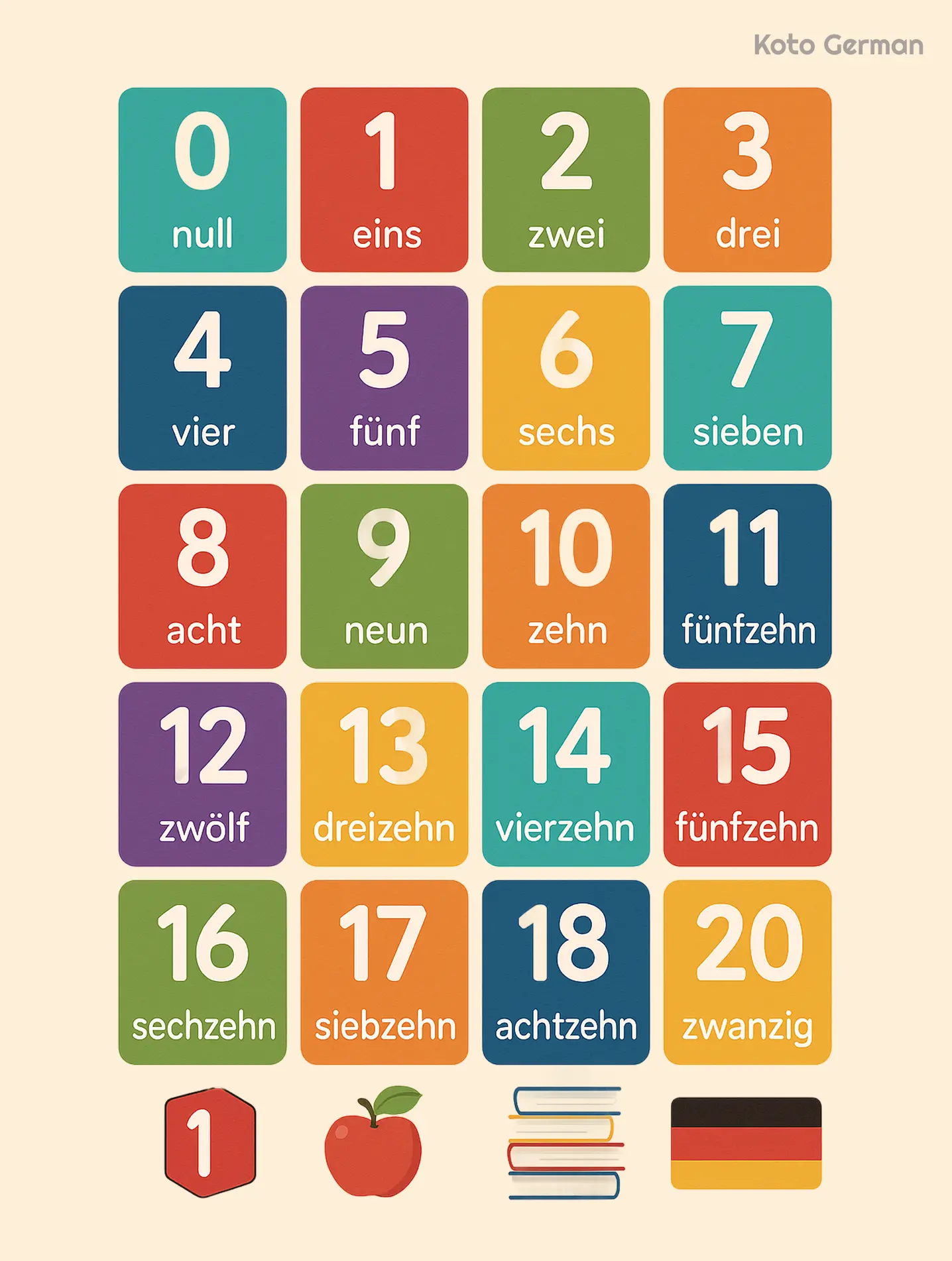
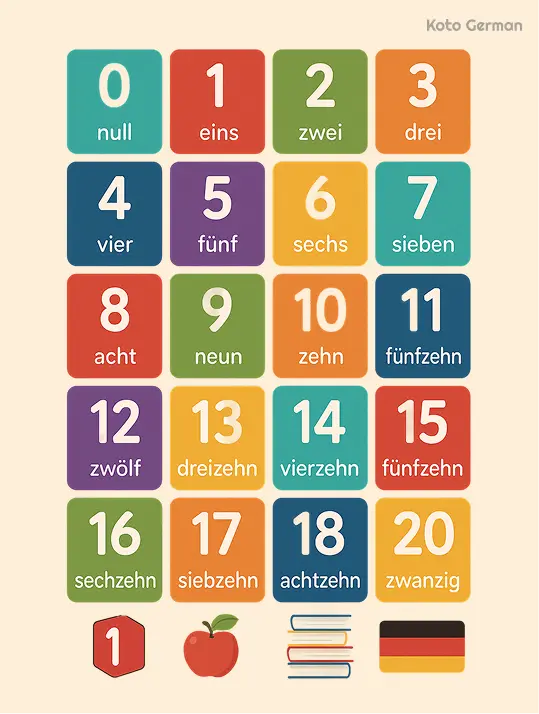
Start with the core numbers from zero to twenty. These form the foundation of German counting and are essential for everyday use. The pronunciation may look tricky at first, but with a bit of practice, the sounds will start to feel natural. Pay attention to unique sounds like the z pronounced as ts and the soft ch. A good grasp here makes learning larger numbers much easier.
| Number | German | Pronunciation |
|---|---|---|
| 0 |
null
|
[nʊl] |
| 1 |
eins
|
[aɪns] |
| 2 |
zwei
|
[tsvaɪ] |
| 3 |
drei
|
[draɪ] |
| 4 |
vier
|
[fiːɐ̯] |
| 5 |
fünf
|
[fʏnf] |
| 6 |
sechs
|
[zɛks] |
| 7 |
sieben
|
[ˈziːbn̩] |
| 8 |
acht
|
[aχt] |
| 9 |
neun
|
[nɔʏn] |
| 10 |
zehn
|
[tseːn] |
| 11 |
elf
|
[ɛlf] |
| 12 |
zwölf
|
[tsvœlf] |
| 13 |
dreizehn
|
[ˈdraɪtseːn] |
| 14 |
vierzehn
|
[ˈfiːɐtseːn] |
| 15 |
fünfzehn
|
[ˈfʏnf tseːn] |
| 16 |
sechzehn
|
[ˈzɛçtseːn] |
| 17 |
siebzehn
|
[ˈziːptseːn] |
| 18 |
achtzehn
|
[ˈaχtseːn] |
| 19 |
neunzehn
|
[ˈnɔɪntseːn] |
| 20 |
zwanzig
|
[ˈtsvantsɪç] |
Watch out for the z sound, which is pronounced like ts. The ch in sechs and acht sounds like a soft kh. To memorize, try repeating in small chunks, focusing on the rhythm.
Tens and Counting by Tens (20–100)
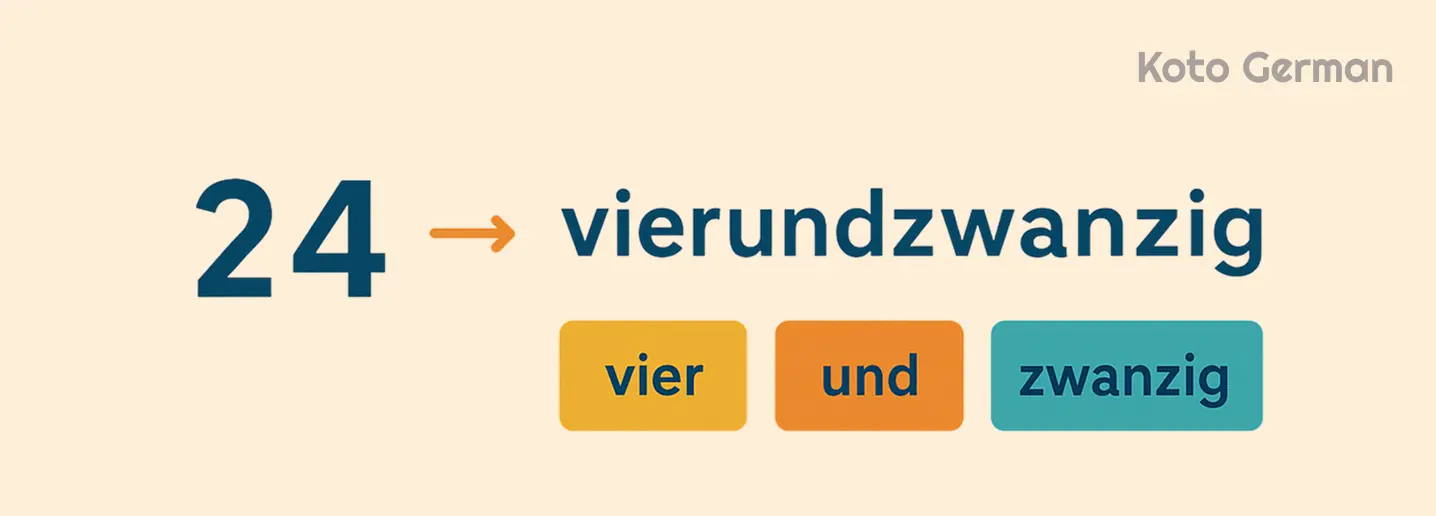

Multiples of ten have distinct names: 20 is zwanzig, 30 is dreißig, 40 is vierzig, and so on up to 100 (hundert). If you can count to 10 in German, you’re already familiar with the building blocks that make these larger numbers easier to learn.
| Number | German | Pronunciation |
|---|---|---|
| 20 |
zwanzig
|
[ˈtsvantsɪç] |
| 30 |
dreißig
|
[ˈdraɪsɪç] |
| 40 |
vierzig
|
[ˈfiːɐtsɪç] |
| 50 |
fünfzig
|
[ˈfʏnf tsɪç] |
| 60 |
sechzig
|
[ˈzɛçtsɪç] |
| 70 |
siebzig
|
[ˈziːptsɪç] |
| 80 |
achtzig
|
[ˈaχtsɪç] |
| 90 |
neunzig
|
[ˈnɔɪntsɪç] |
| 100 |
hundert
|
[ˈhʊndɐt] |
German numbers put the unit before the ten with und in between. For example, 21 is einundzwanzig (one and twenty), 47 is siebenundvierzig (seven and forty).
The rule might feel upside down at first, but it’s a neat pattern once you get it.
Large Numbers and Hundreds
Forming numbers from 100 to 999 in German follows a clear structure, but it comes with a twist of its own. You begin with the hundred (hundert, zweihundert, dreihundert, etc.), then attach the rest of the number — all in one continuous word.
For example:
- 100 =
hundert - 200 =
zweihundert - 245 =
zweihundertfünfundvierzig
As you can see, the components don’t stand alone. German combines them into a single compound word, and there are no spaces or hyphens. The same inverted rule from earlier still applies — the unit comes before the ten. So 245 literally reads as two hundred five and forty.
This might look overwhelming at first glance, but there’s a method to the madness. Once you learn how each piece fits, it becomes like stacking blocks. How do you say numbers in German? Practice reading longer numbers aloud, breaking them down into chunks, and you’ll start to recognize the pattern instantly.
Thousands and Millions
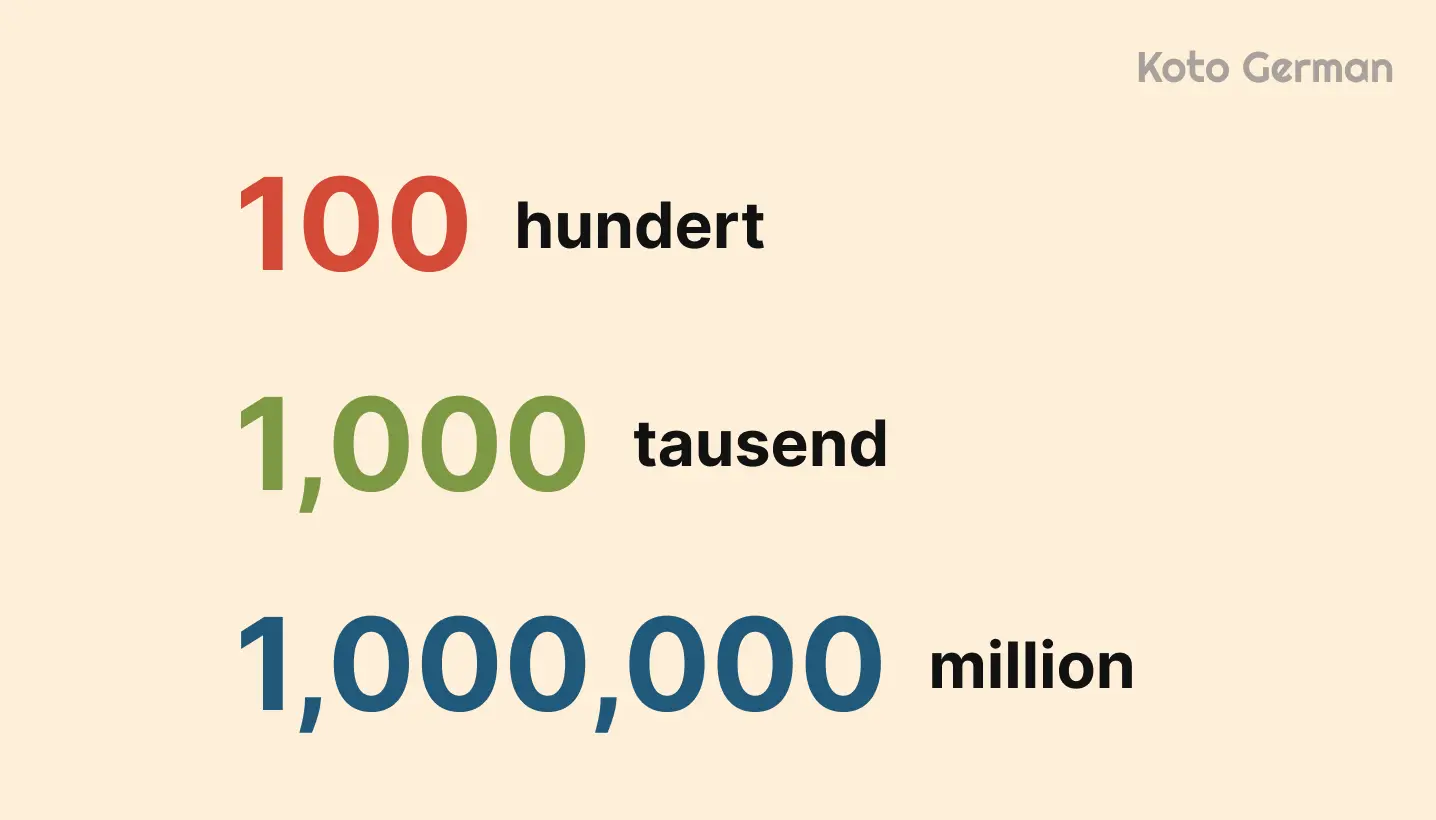
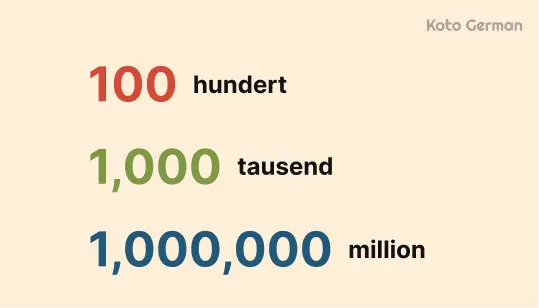
Entering the thousands, you’ll notice that German stays true to its pattern. Tausend serves as the base, and everything else is stacked behind it without spaces.
For example:
- 1,000 =
eintausend - 10,000 =
zehntausend - 12,345 =
zwölftausenddreihundertfünfundvierzig
Once you’re comfortable with hundreds and thousands, challenge yourself with longer numbers. These compound words might seem long, but they follow the same pattern.
Here are a few examples with pronunciation:
| Number | German | Pronunciation |
|---|---|---|
| 1,327 |
eintausenddreihundertsiebenundzwanzig
|
[ˈaɪntaʊ̯zn̩tˌdʁaɪ̯hʊndɐtˌziːbn̩ʊntˈtsvantsɪç] |
| 4,589 |
viertausendfünfhundertneunundachtzig
|
[ˈfiːɐ̯taʊ̯zn̩tfʏnfˌhʊndɐtˌnɔʏnʊntˈaχtsɪç] |
| 9,999 |
neuntausendneunhundertneunundneunzig
|
[ˈnɔʏntaʊ̯zn̩tˌnɔʏnhʊndɐtˌnɔʏnʊntˈnɔʏntsɪç] |
Break them into chunks while speaking — Tausend + Hundert + rest. It helps with both rhythm and clarity.
The pattern stays consistent — start with the thousands, add the hundreds, then follow with the tens and units. It may look like a mouthful, but once you know the parts, it’s just a matter of putting them in the right order.
For larger figures, German introduces new vocabulary:
- Million (die Million) is a feminine noun and always capitalized.
- Milliarde is the word used for what English speakers call a billion (that’s one thousand million).
When using Million or Milliarde, you also need to apply proper grammar. For example:
- 2,000,000 =
zwei Millionen - 3,000,000,000 =
drei Milliarden
Another key detail is punctuation. German flips the script when it comes to commas and periods in numbers. A period separates thousands (e.g., 1.000 for one thousand), while a comma is used for decimals (e.g., 1,5 for one and a half). This small difference can lead to big misunderstandings, especially with prices or statistics, so it’s worth double-checking when reading figures in German.
Level up your German with Koto!
Ordinal Numbers in German

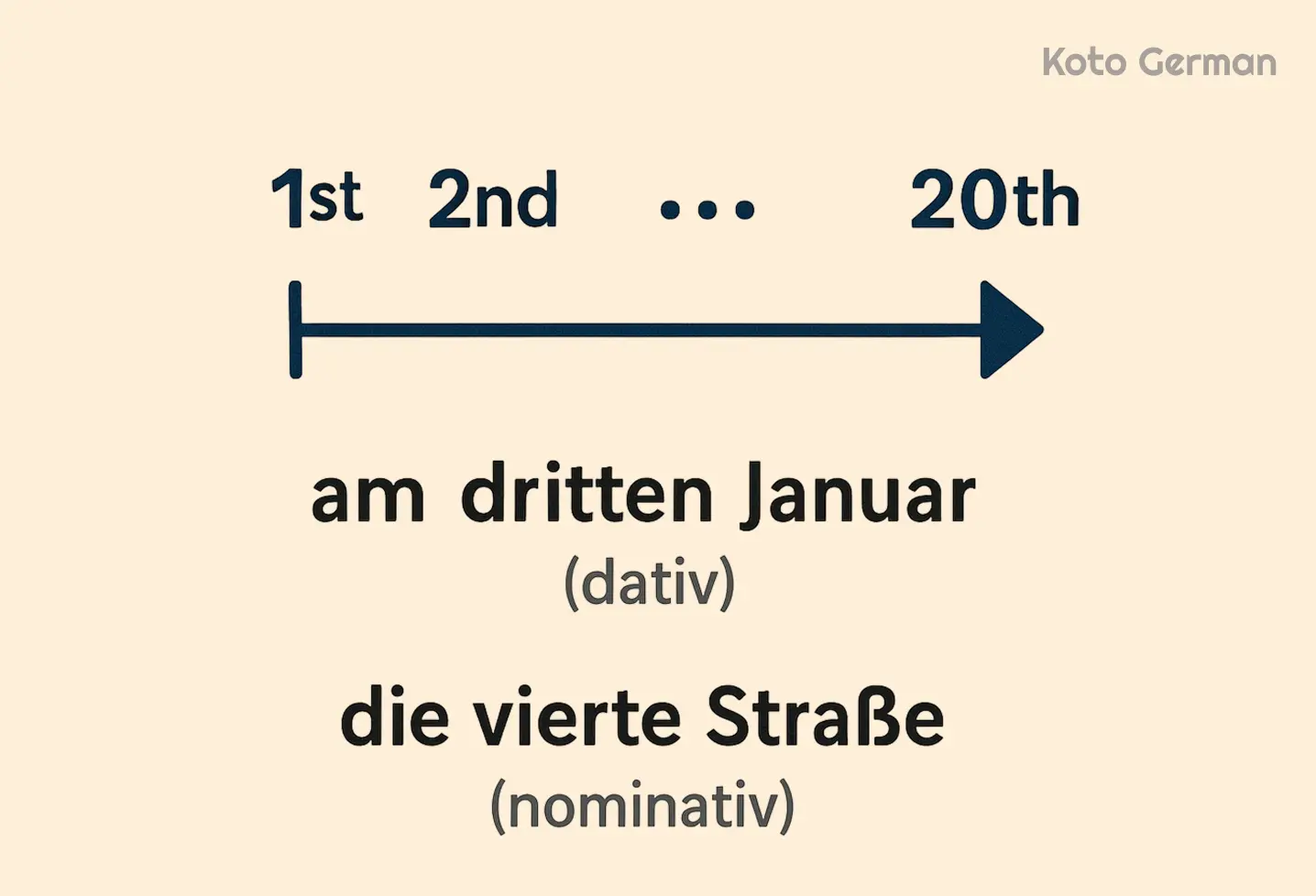
If you’re ready to move beyond just how many and start talking about which one, then welcome to the world of ordinal numbers. These are the words we use to describe position or order, like first, second, and third.
In German, ordinal numbers are everywhere: in rankings, birthdays, street addresses, and just about any scenario where things need to be put in line. Pay attention to numbers in German pronunciation here — getting the endings right will help you sound more natural and confident.
Unlike the cardinal numbers (eins, zwei, drei…), German ordinal numbers are built with specific endings and follow a neat system, at least most of the time.
Here’s a quick look at the most common ones, from 1st to 20th:
| English | German |
|---|---|
| 1st |
erste
|
| 2nd |
zweite
|
| 3rd |
dritte
|
| 4th |
vierte
|
| 5th |
fünfte
|
| 6th |
sechste
|
| 7th |
siebte
|
| 8th |
achte
|
| 9th |
neunte
|
| 10th |
zehnte
|
| 11th |
elfte
|
| 12th |
zwölfte
|
| 13th |
dreizehnte
|
| 14th |
vierzehnte
|
| 15th |
fünfzehnte
|
| 16th |
sechzehnte
|
| 17th |
siebzehnte
|
| 18th |
achtzehnte
|
| 19th |
neunzehnte
|
| 20th |
zwanzigste
|
From 21st onward, things stay predictable: you take the full number and tack on -ste.
- 21st =
einundzwanzigste - 45th =
fünfundvierzigste - 100th =
hundertste
In real conversations and writing, ordinal numbers change their endings depending on the grammatical case, just like adjectives do.
Here are some examples:
-
Nominative (who or what?):
Diefünfte Etage ist ganz oben. -
Dative (when or where?):
Amfünften Mai feiern wir. -
Accusative (whom or what?):
Ich nehme dendritten Platz. -
Genitive (whose?):
Das ist das Ergebnis dessiebten Spiels.
Pay attention to endings like -e, -en, or -es — they change based on gender, number, and case. If you already know adjective endings, you’re ahead of the game!
The only thing that changes is spelling in a few irregulars like erste, dritte, and siebte. After that, it’s mostly smooth sailing.
You’ll spot these sequential numbers in the German language everywhere — from sports rankings (der dritte Platz = third place) to event dates (am zwölften Januar = on the 12th of January). They’re especially useful when talking about someone’s birthday or listing steps in a process.
We’ll dive deeper into how ordinal numbers work in full dates and time expressions in the next chapter. For now, just remember: in German, placing something in order is as easy as adding a little -ste.
How to Say Dates, Time, and Prices in German
Let’s face it — no matter how good your grammar is, if you can’t tell someone what time dinner is, when your birthday falls, or how much that delicious-looking pastry costs, you’re going to feel a bit stuck. The good news? German handles dates, time, and prices with charming logic and just enough quirks to keep things interesting.
Dates
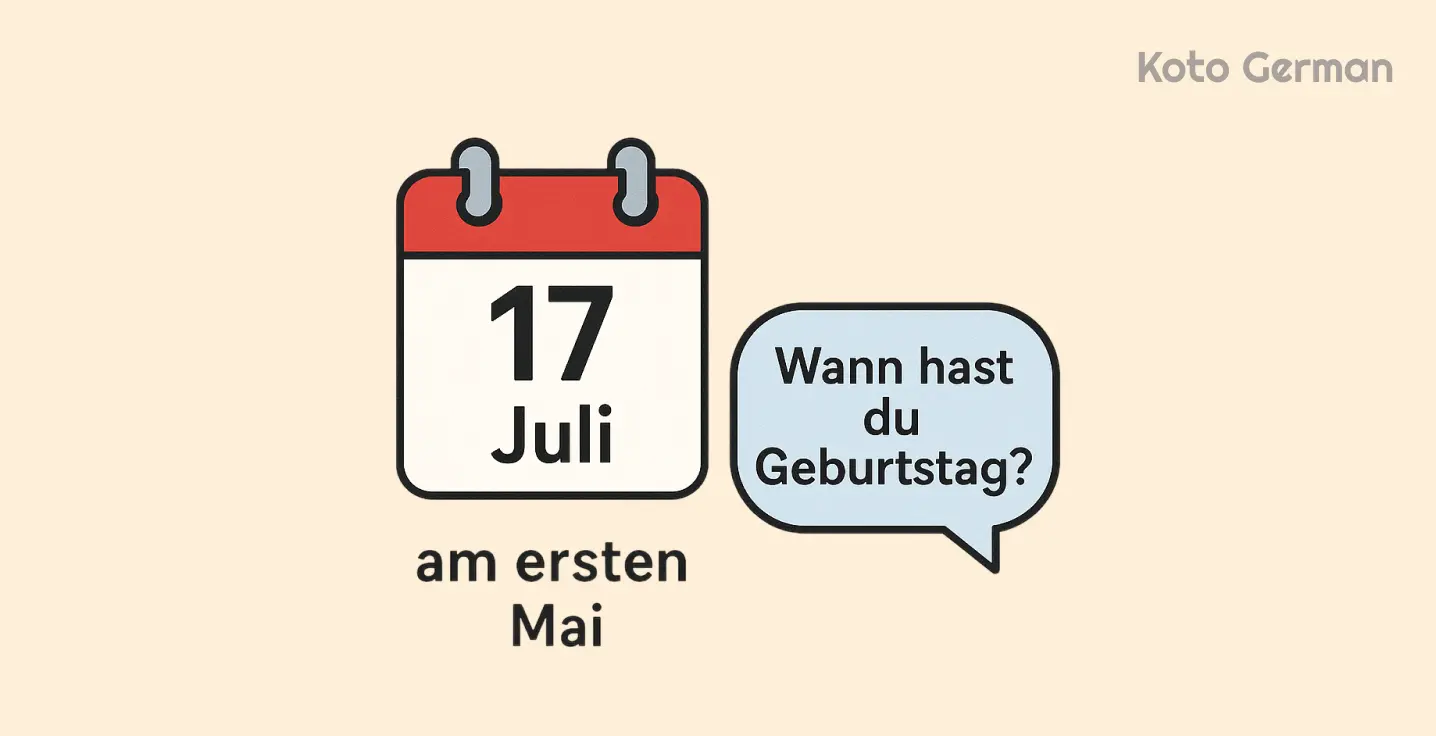
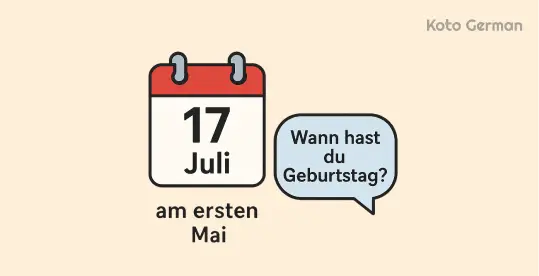
Dates in German use ordinal numbers (first, second, third…) combined with the name of the month. But here’s the trick — you need to use the dative case with the article am (meaning “on the”). So instead of saying January third, you say:
You’ll hear this in everything from formal invitations to casual conversations:
In written German, dates are often styled like this — 17. Juli — with a period after the number to show it’s ordinal. A list of numbers in German is a great place to start if you’re brushing up on how to read or write dates correctly.
Time
Time in German plays by its own rules, and one of the most iconic quirks is how they tell the half hour. Instead of saying half past eight, Germans say:
Yes, halb neun means 8:30, not 9:30. Think of it like a countdown: you’re halfway to nine. Once you get used to it, it feels surprisingly natural.
Other handy time phrases:
And if someone says Es ist genau zwölf Uhr, you’re right on time — it’s exactly twelve o’clock.
Prices
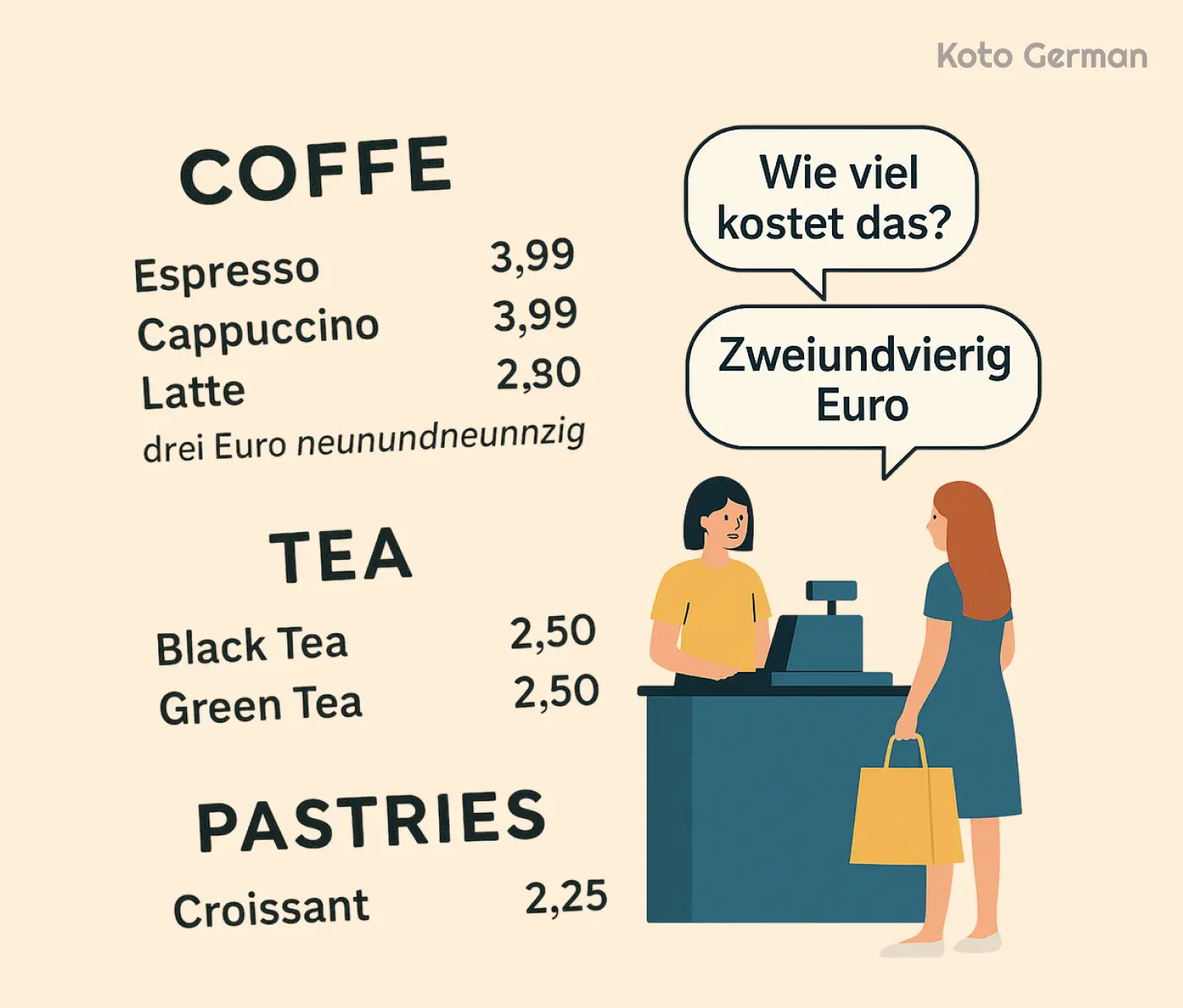
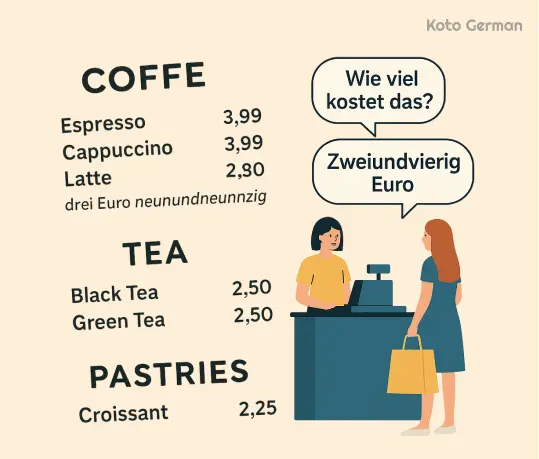
Now let’s talk money. Germans use commas for decimals, so 3,99€ is what English speakers know as “three euros and ninety-nine cents.” In conversation, it rolls off the tongue like this:
You’ll hear this everywhere — at the bakery, the market, the train station:
Im Kleidungsgeschäft (at the clothing store):
Im Café (at the café):
Beim Ticketkauf (buying tickets):
Im Buchladen (at the bookstore):
Planning a meet-up, catching a train, or grabbing change at the checkout — these phrases turn textbook German into real-life German. Once you’ve cracked how locals twist time, slice prices, and flip dates, everyday chats start flowing like clockwork.
Common Mistakes to Avoid
German 1-100 waiting to trip you up. Here’s how to dodge them like a pro.
-
Mixing up the order
In German, numbers do a little dance. Einundzwanzig means one and twenty, not the other way around. Say zwanzigeins and you might get polite chuckles. Flip the script like the locals, start with one, then add the twenty.
Ich bin zwanzigeins Jahre alt.Ich bin einundzwanzig Jahre alt.Ich habe dreißigzwei Euro.Ich habe zweiunddreißig Euro.German numbers put the smaller number first, then the bigger one. Getting this order right makes you sound fluent instead of like a beginner stumbling over words.
-
Falling for false friends
Words like Billion can get sneaky. In English, that’s a thousand million. In German, eine Billion means a trillion. Yep, you just accidentally inflated your budget.
Ich habe nur ein Paar Äpfel.Ich habe nur zwei Äpfel.Das Unternehmen macht eine Billion Gewinn.Das Unternehmen macht eine Milliarde Gewinn.False friends look familiar but can trip you up. For example, Billion means trillion in German — not billion. And ein Paar means a few, not exactly two. Mixing these up can cause big confusion or exaggeration. Always double-check to keep your German clear and accurate.
-
Decimal drama and comma chaos
In Germany, a comma is used where English speakers would expect a decimal point. So €3,50 is three euros and fifty cents, not three thousand five hundred euros. That comma can cost you, especially if you’re just learning how to write numbers in German.
Das kostet €3.500.Das kostet €3,50.Ich habe €1,000.Ich habe €1.000.In German, the period separates thousands, while the comma marks decimals. Mixing them up can cause costly confusion, so watch those little dots and commas carefully!
It can feel a little mixed up in the beginning, but that’s the German way with numbers. Imagine each number as a little brain twist. Say the smaller chunk first, then tack on the bigger one. Soon enough, zweiundsechzig and vierundneunzig will roll off your tongue with ease.
Tips for Learning German Numbers Faster
Trying to learn every German number can feel like following a recipe written in reverse. First the flour, then the eggs? No, first the one, then the twenty. Once you flip the switch, though, the pattern sticks.
-
Use mnemonics that stick
Turn number words into quirky images or associations. For example, acht (eight) sounds a bit like acht! — a shout you might make when dodging something flying your way. Picture eight angry bees heading your direction. The weirder the image, the better it sticks. For sechzehn (sixteen), imagine sixteen socks (sechs Socken?) tumbling from your closet.
-
Flip it and remember it
German double-digit numbers are famously backward. Zweiundvierzig literally means two and forty. Use the rhyme: Little number leads the dance, big one follows if there’s a chance. You can even imagine the smaller number tugging the big one by the hand, which makes it easier to visualize and recall.
-
Flashcards, but smarter
Old-school flashcards still work, but level them up. Create physical or digital cards that not only show the number word but also link to a real-life visual, like a train ticket with neunzehn or a price tag reading €3,49. Try to include all numbers in German, not just the basics. Bonus points if your cards quiz you both ways: number → word and word → number.
-
Talk it out loud
Reading is good. Saying is better. Out loud. In the mirror. In the shower. Your brain connects faster when your voice gets involved. Talk your day through in German numbers: Ich habe zwei Kaffees getrunken. Es ist siebzehn Uhr. Odd? Sure. Useful? Absolutely.
Lastly, go hands-on. Use real-life materials — receipts, prices at the store, train timetables, even German menus. Practicing in the wild trains your brain to recognize and respond to numbers under pressure, which is how you know it’s working.
Enjoy personalized learning!
Time for a Quick Quiz
Being fluent with numbers makes speaking German more natural. Take on this challenge and see how well you know them.
Conclusion
Numbers in German 1-10 don’t have to be scary. You’ve just unlocked one of the most practical parts of German, and that’s something to feel good about.
Quick wins:
- You can now count like a local
- You understand dates and appointments
- You’re ready to handle prices and quantities
Keep going — the more you use them, the smoother it gets.
FAQ: Common questions about counting in German
In German, large numbers are grouped just like in English, but with some linguistic twists:
- 1,000 =
eintausend - 10,000 =
zehntausend - 100,000 =
hunderttausend - 1,000,000 =
eine Million (note the feminine artile)
Million and higher units like Milliarde (billion) act like nouns and decline accordingly.
German numbers switch the order: you say one and twenty instead of twenty-one. It follows this structure until 99, so it’s worth getting familiar with all German numbers early on.
- 21 =
einundzwanzig - 48 =
achtundvierzig
Strange at first, but your brain adapts faster than you’d think.
Both mean “100,” and you can use them interchangeably.
- Hundert is more common in casual speech.
- Einhundert sounds more formal or is used for clarity in counting.
You might spot einhundert more often in textbooks, bank statements, or math class. When chatting with friends, though, hundert keeps things short and sweet.
Germans use a comma instead of a period for decimals:
- 3.14 (English) = 3,14 (German)
And a period for thousands:
- 1,000 (English) = 1.000 (German)
So yes, when writing a number in German, it’s a bit flipped — mind the dot and comma dance.



